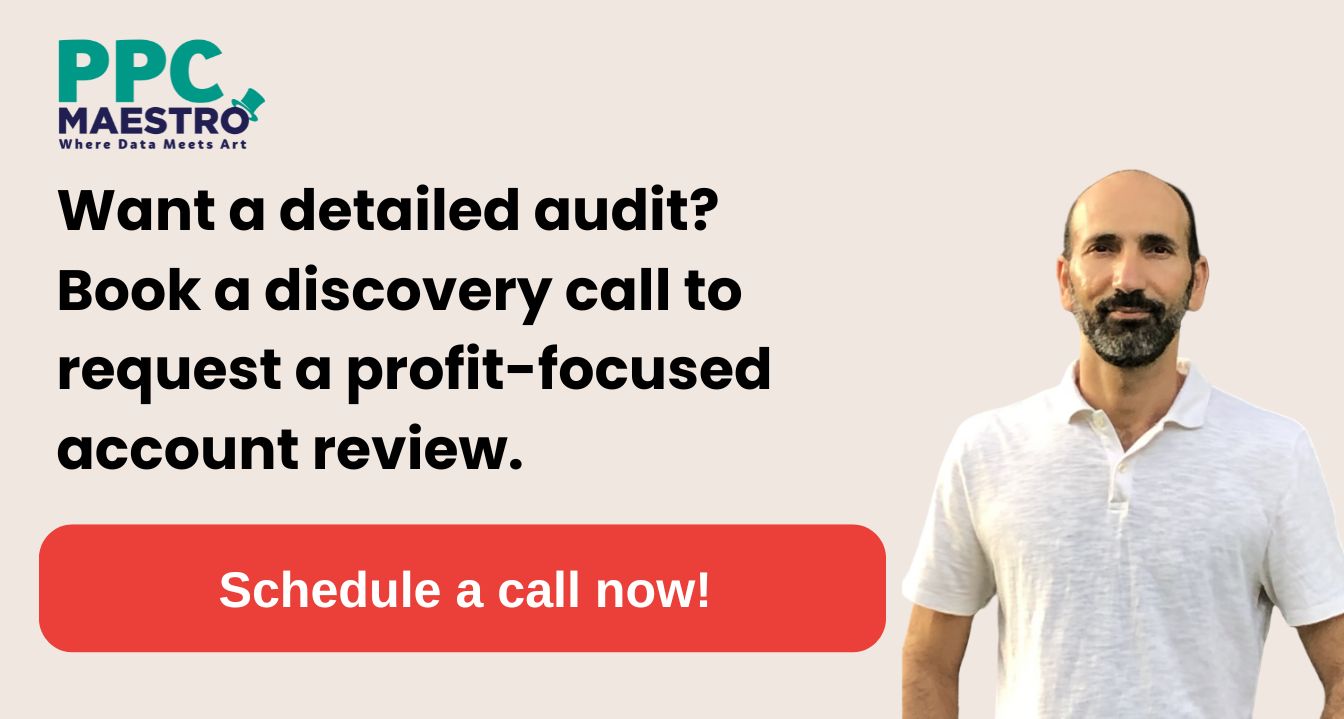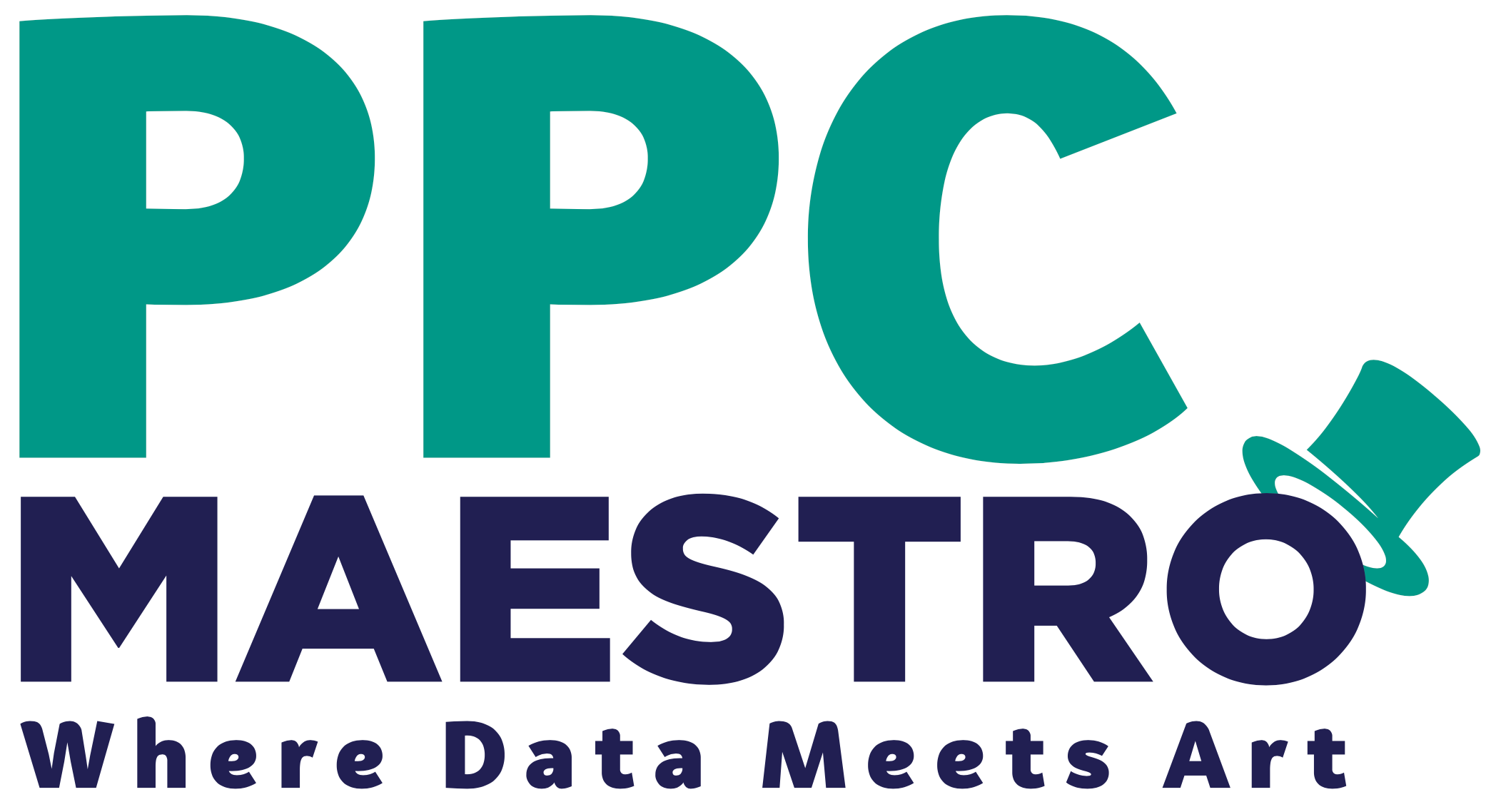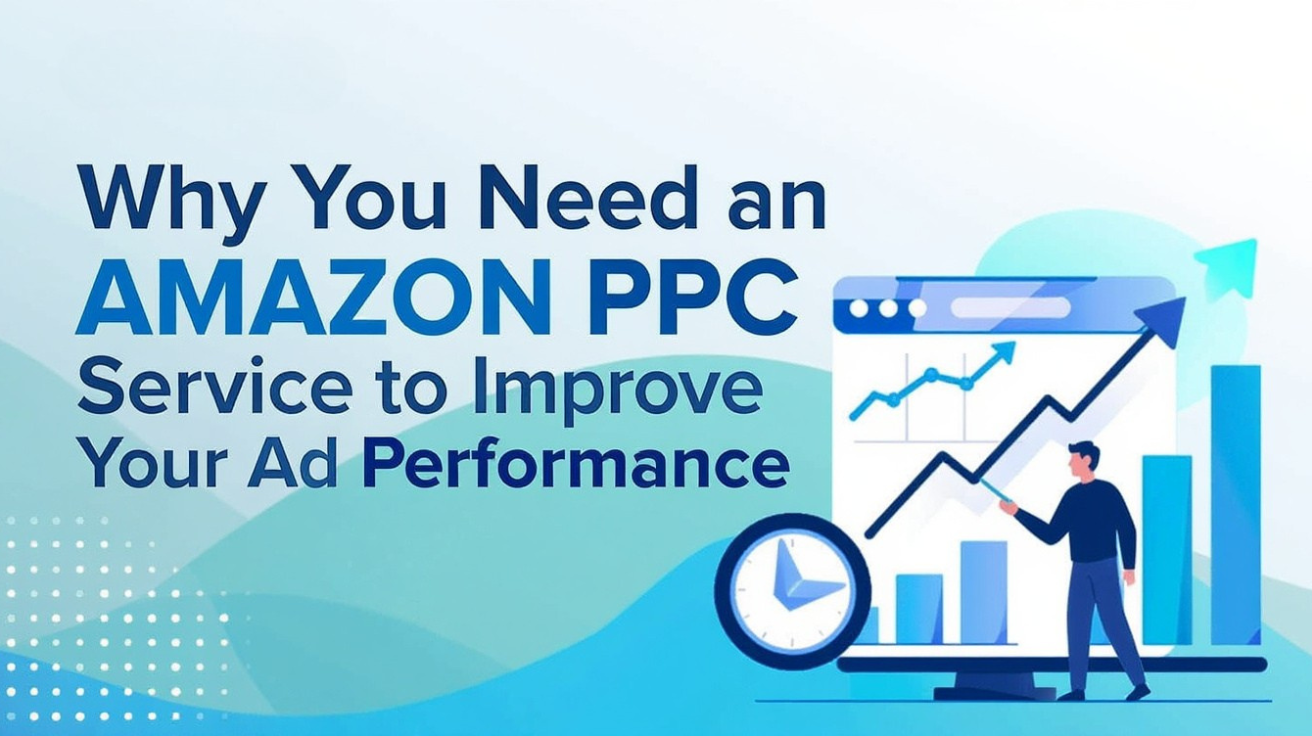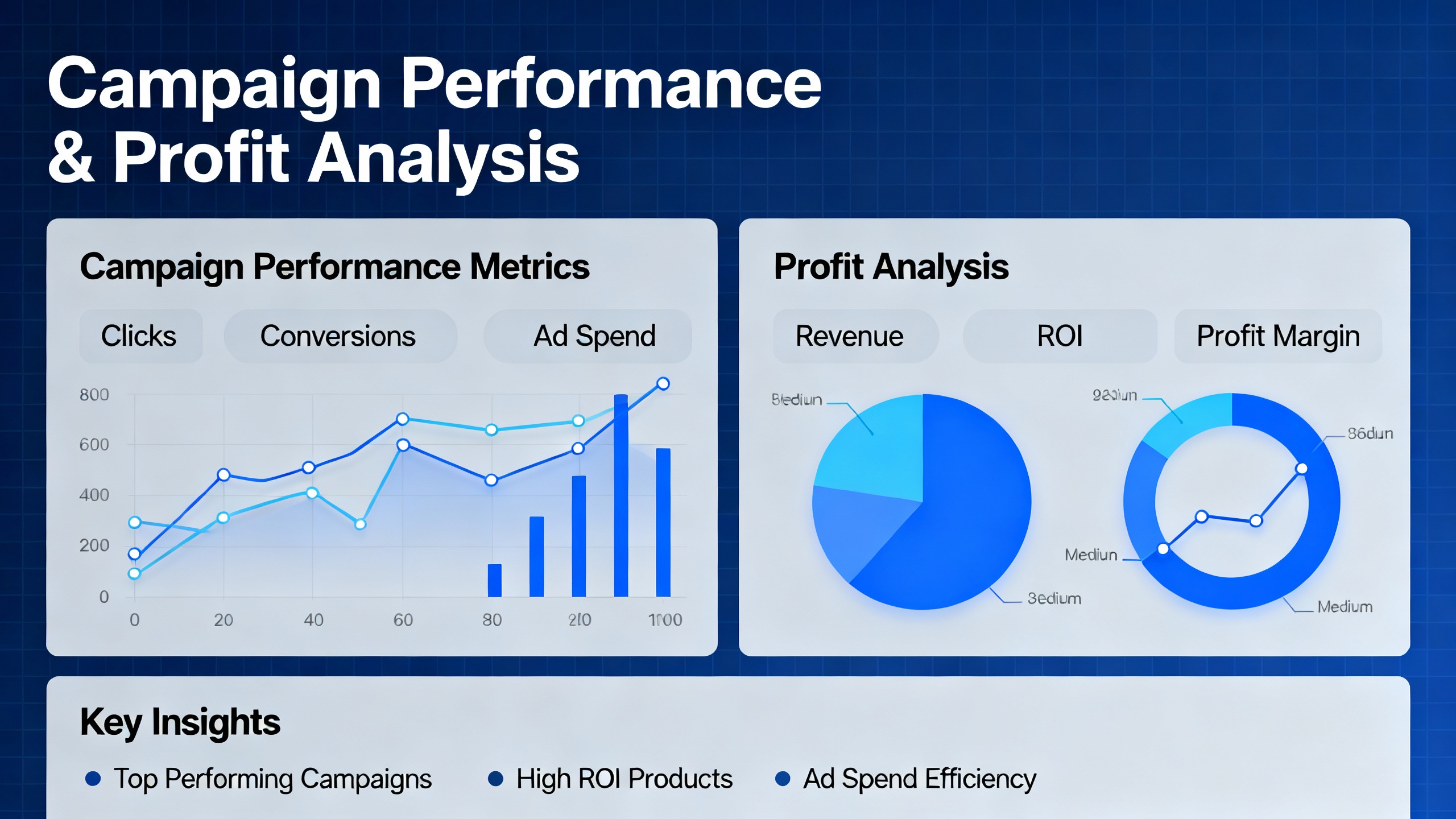An Amazon PPC audit systematically reviews search term performance, campaign structure, bid efficiency, and TACoS alignment to identify wasted spend and build a profit-first optimization roadmap.
Introduction
Last month, I analyzed a seven-figure Amazon advertising account. More than 40% of ad spend went to search terms that generated zero purchases.
When margins shrink and Total Advertising Cost of Sale (TACoS) climbs month over month, an Amazon PPC audit becomes the fastest diagnostic tool to stop budget waste and build a profitable advertising strategy.
This guide explains what professional audits include, common findings from real accounts, and how to evaluate audit deliverables.

What a Professional Amazon PPC Audit Includes
A comprehensive audit examines six core areas:
1. Search Term Report Analysis
Reviews actual customer queries that triggered ads. According to Amazon Seller Central documentation, search term reports reveal which queries drive conversions versus which drain budgets without sales.
The audit identifies:
High-spend, zero-conversion terms
Irrelevant traffic from broad match keywords
Negative keyword opportunities
2. Campaign Structure Assessment
Evaluates:
Naming conventions and organizational logic
Match type distribution (exact, phrase, broad)
Campaign type alignment (Sponsored Products, Brands, Display)
Budget allocation across campaign tiers
According to Amazon Advertising best practices, proper campaign structure prevents budget cannibalization and improves performance tracking.
3. Bid and Budget Diagnostics
Analyzes:
Overbidding on low-margin keywords
Underfunded high-performers
Bid adjustment rules and their margin impact
Daily budget limitations throttling winners
4. Placement Performance Review
Examines performance across:
Top of search (first page)
Rest of search
Product detail pages
Research from Amazon's advertising console shows placement modifiers can shift 30-50% of total spend—making this a critical audit component.
5. TACoS and Margin Alignment
Maps advertising efficiency against actual profitability:
ACoS (Advertising Cost of Sale): ad spend ÷ attributed sales
TACoS (Total Advertising Cost of Sale): ad spend ÷ total sales
Contribution margin: net profit after advertising, COGS, and fees
Industry analysis from Perpetua's 2024 benchmark report shows sellers who track TACoS by SKU margin outperform those optimizing for ACoS alone.
6. Audit Deliverables
Professional audits provide:
Findings presentation: visual dashboard of waste areas and opportunities
Prioritized action plan: ranked by impact and implementation effort
Implementation resources: bulk upload files, negative keyword lists, SOPs
30-60-90 day roadmap: phased optimization timeline
Common Findings in Real Amazon PPC Audits
Based on analysis of 200+ Amazon advertising accounts, these patterns emerge consistently:
1. Low-Intent Search Term Waste
The problem: Broad match keywords trigger ads for tangentially related searches that never convert.
Example: A "yoga mat" seller pays for clicks on "yoga classes near me" and "yoga instructor certification."
The fix: Mine search term reports weekly and add non-converting queries to negative keyword lists.
2. Match Type Mismanagement
The problem: Broad match campaigns consume 60-80% of budget while exact match campaigns with proven converters remain underfunded.
The fix: Rebalance budgets toward exact and phrase match winners; restrict broad match to discovery-only campaigns with lower bids.
3. Bid Cannibalization Across Campaigns
The problem: Multiple campaigns compete in the same auctions (auto campaigns, broad campaigns, exact campaigns all bidding on identical terms).
The fix: Implement negative keyword cascades so broad campaigns defer to exact match, preventing internal bidding wars.
4. Incomplete Negative Keyword Coverage
The problem: Negative lists never created or not applied consistently across campaign groups.
According to Amazon's negative keyword guidance, proper negative keyword strategy can reduce wasted spend by 15-25%.
The fix: Build master negative lists at campaign and ad group levels; update weekly based on search term reports.
5. Margin-Blind TACoS Targets
The problem: Advertising targets set as "keep ACoS under 30%" without considering product margins, which may be 25% or 60%.
The fix: Set SKU-specific TACoS guardrails based on contribution margin. A 60% margin product can sustain 35% TACoS profitably; a 25% margin product cannot.

How to Turn Audit Findings Into Profit
Quick-Win Implementations (Week 1-2)
Bulk negative keyword upload:Export all non-converting search terms from the past 60 days. Filter by zero orders and >$20 spend. Upload as negative exact matches.
Expected impact: 10-20% immediate spend reduction with no revenue loss.
Pause non-converting ASINs:Identify products with >50 clicks and zero conversions. Pause those ad groups and reallocate budget to top converters.
Expected impact: 5-15% budget reallocation to profitable SKUs.
Placement bid adjustments:Review placement reports. If "product detail pages" show 3x higher ACoS than "top of search," reduce placement modifier from +50% to 0%.
Expected impact: 8-12% ACoS reduction on reallocated placements.
Structural Changes (Week 3-6)
Campaign reorganization:Separate discovery (broad/phrase match, lower bids) from conversion (exact match, higher bids) campaigns. Apply negative lists so broad campaigns don't compete with exact.
Margin-aligned TACoS targets:Calculate contribution margin by SKU:
Contribution Margin = (Sale Price - COGS - Amazon Fees - Shipping) ÷ Sale Price
Set maximum TACoS at 50-60% of contribution margin to maintain profitability.
Example:
Product margin: 40%
Sustainable TACoS: 20-24%
Ongoing Optimization (Months 2-3)
Weekly search term mining: Schedule recurring negative keyword reviews every Monday.
Monthly campaign audits: Review top 20 campaigns for bid drift and budget pacing.
Quarterly margin analysis: Reassess TACoS targets when COGS or Amazon fees change.
For detailed implementation workflows, refer to Amazon's campaign optimization playbook.
What to Expect From a Quality Audit Partner
Audit Scope and Timeline
Typical timeline: 7-14 business days from account access to deliverable presentation.
"24-hour audits" with no search term analysis
One-page PDFs with generic recommendations
No margin or TACoS discussion
No implementation plan or bulk files
Deliverable Standards
A credible audit includes:
Executive summary: Top 5 findings with dollar impact estimates
Detailed findings deck: 15-25 slides covering search terms, structure, bids, placements, margins
Action plan spreadsheet: Prioritized tasks, owners, expected impact, completion dates
Implementation resources: Bulk upload files, negative keyword templates, SOP documents
Success metrics: KPIs to track (TACoS, wasted spend %, margin per click)
Internal vs. Agency Execution
Internal execution works when:
Team has 5+ hours per week for PPC optimization
Access to bulk editing tools and reporting dashboards
Experience with search term mining and negative keyword strategy
Agency partners add value when:
Team lacks PPC-specific expertise
Bandwidth doesn't allow weekly optimization
Account complexity (100+ campaigns, multi-brand portfolios)
Need for accountability and performance reporting
At PPC Maestro, our audit deliverables include both self-service SOPs and optional managed implementation with weekly progress tracking.
How to Measure Audit Success
Stop Celebrating ACoS in Isolation
The ACoS trap: A campaign with 20% ACoS looks efficient—until you realize the product margin is 22%. You're losing 2% on every sale.
Track These Metrics Instead
1. TACoS by SKUFormula: Total ad spend ÷ total revenue (all sources) per product
Why it matters: Shows whether advertising grows overall business or just cannibalizes organic sales.
Target: TACoS should be 40-60% of your contribution margin.
2. Contribution Margin Per ClickFormula: (Revenue - COGS - Fees - Ad Spend) ÷ Clicks
Why it matters: Reveals actual profitability of traffic, not just conversion efficiency.
Target: Positive and increasing month-over-month.
3. Wasted Spend PercentageFormula: (Spend on zero-order terms) ÷ (Total spend)
Why it matters: Direct measure of audit effectiveness.
Target: <10% after implementing negative keyword strategies.
4. Budget Efficiency ScoreFormula: (Spend on top 20% converting terms) ÷ (Total spend)
Why it matters: Confirms budget flows to winners, not waste.
Target: >60% of spend concentrated in proven converters.
For dashboard templates, see Amazon Attribution and reporting tools.
When to Schedule Your Next Audit

Quarterly Audits for Active Accounts
If you run >$10,000/month in ad spend, schedule audits every 90 days. Campaign performance drifts as:
Seasonal search behavior changes
Competitors adjust bids
New ASINs launch
Inventory and promotions shift
Trigger-Based Audits
Run an immediate audit when:
TACoS increases >5 percentage points month-over-month
Total ad spend grows but attributed revenue stays flat
New product launches underperform despite high spend
Major campaign structure changes (switching to Sponsored Brand Video, launching DSP)
Conclusion
An Amazon PPC audit is diagnostic work, not guesswork. It reveals where your budget flows, where it converts, and where it burns.
When done correctly, an audit delivers three outcomes:
Immediate waste elimination: Cut 10-20% of spend in the first two weeks
Strategic reallocation: Shift budget to proven winners and margin-positive opportunities
Profit-first roadmap: Align TACoS targets with actual margins so advertising drives profit, not just sales
If your ad spend is growing faster than your profit, start with an audit.
Book a discovery call for a profit-first Amazon PPC audit. Receive a detailed findings deck and 30-day action plan.
Download our audit checklist to run an internal review using our search term mining and negative keyword frameworks.
See client results from recent audits, including anonymized TACoS improvements and waste reduction metrics.
Frequently Asked Questions
Q: What does an Amazon PPC audit include?
A: A thorough PPC audit examines search term reports to identify non-converting queries, reviews campaign structure for match type balance and budget allocation, analyzes bid efficiency and placement performance, evaluates negative keyword coverage, and maps TACoS targets to actual product margins. Professional audits deliver a findings presentation, prioritized action plan, bulk implementation files, and a 30-90 day optimization roadmap.
Q: How soon will I see results after implementing audit fixes?
A: You can observe wasted spend reductions within 3-7 days of applying negative keywords and pausing non-converting placements. Sustained profit improvement requires 30-60 days as budget reallocates to proven converters and margin-aligned TACoS targets take effect. Track weekly metrics: wasted spend percentage, TACoS by SKU, and contribution margin per click.
Q: How much does an Amazon PPC audit cost?
A: Audit pricing varies by account complexity. Self-service audit tools start at $200-500. Professional agency audits for accounts spending $10,000-50,000/month typically cost $1,500-3,500. Enterprise audits (multi-brand portfolios, $100,000+/month spend) range from $5,000-15,000. Most agencies offer free preliminary assessments during discovery calls.
Q: Can I run an audit internally or should I hire a specialist?
A: Internal teams can conduct effective audits if they have: (1) access to Amazon Advertising console and bulk editing tools, (2) 5-10 hours per week for search term mining and optimization, (3) knowledge of contribution margin calculations and TACoS strategy. Agencies accelerate execution, provide external accountability, and bring pattern recognition from managing hundreds of accounts—valuable when internal bandwidth is limited or PPC expertise is developing.
Q: Will an audit guarantee lower ACoS?
A: Reputable auditors do not guarantee specific ACoS outcomes because results depend on implementation quality, market conditions, and product-market fit. However, audits should quantify expected impact: "Based on $X in identified wasted spend, we estimate 12-18% ACoS reduction if recommendations are implemented fully within 30 days." Request case studies with anonymized metrics to evaluate an auditor's track record.
Cited Works
Amazon Seller Central — "Search Term Report." Seller Central Help Documentation. https://sellercentral.amazon.com/help/hub/reference/G202725160. Accessed November 11, 2025.
Amazon Advertising — "Campaign Structure Best Practices." Amazon Advertising Resource Library. https://advertising.amazon.com/library/guides/campaign-structure. Accessed November 11, 2025.
Amazon Advertising — "Placement Optimization Strategies." Amazon Advertising Resource Library. https://advertising.amazon.com/library/guides/placement-optimization. Accessed November 11, 2025.
Amazon Advertising — "Negative Keywords Guide." Amazon Advertising Resource Library. https://advertising.amazon.com/library/guides/negative-keywords. Accessed November 11, 2025.
Perpetua — "Amazon Advertising Benchmarks 2024." Perpetua Resources. https://perpetua.io/resources/amazon-advertising-benchmarks/. Published 2024. Accessed November 11, 2025.
Amazon Advertising — "Campaign Optimization Strategies." Amazon Advertising Resource Library. https://advertising.amazon.com/library/guides/campaign-optimization-strategies. Accessed November 11, 2025.
Amazon Advertising — "Amazon Attribution and Reporting." Amazon Advertising Solutions. https://advertising.amazon.com/solutions/products/amazon-attribution. Accessed November 11, 2025.





